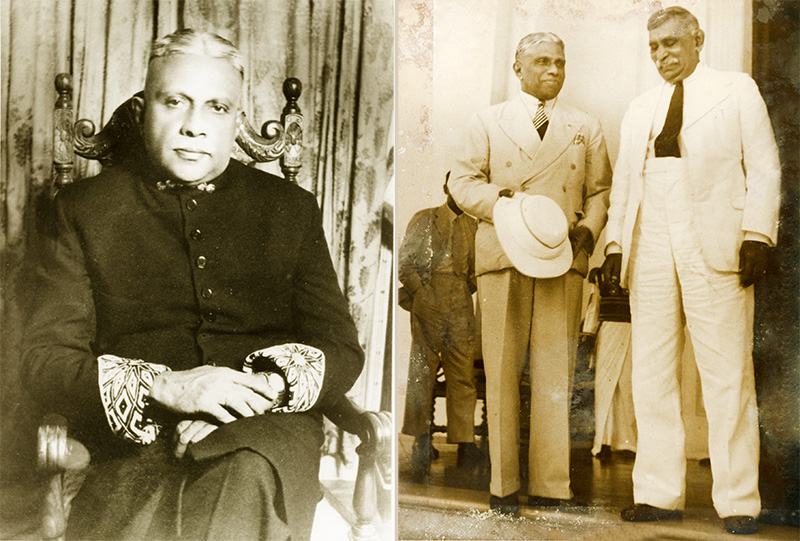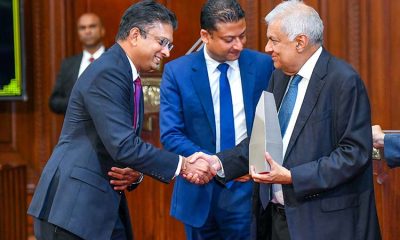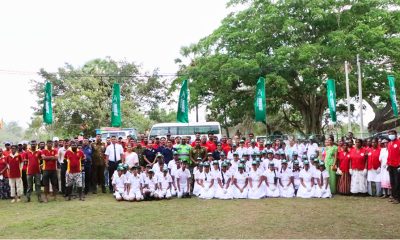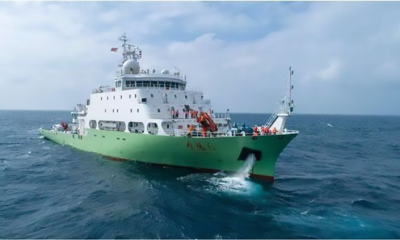Opinion
Prof Jayasiri Lankage (1936-2024):Pioneer in Library and Information Science education

Prof Jayasiri Lankage who died recently was born on September 10, 1936 at Kekanadura, Matara, studied for the GCE (AL) at Dharmasoka College, Ambalangoda in 1957 and entered to Vidyodaya University (Presently Sri Jayewardenepura University) earning a BA general degree in 1962. He then did a BA Honors degree in Archaeology in 1964 and an MA in Archaeology in 1967 at the same university. He obtained his postgraduate qualifications from Banaras Hindu University in 1969 under an Indian government scholarship granted in 1967.
After his higher education in India, he worked as a Lecturer in Library and Information Science, at the Junior University in Dehiwala between 1969-70. He then became the first lecturer in library science at the Kelaniya University on June 1, 1973. He was later Head of Department at the Department of Library and Information Science, University of Kelaniya (then Vidyalankara Campus) being the pioneer in this department of study.
During his tenure as head of department, Professor Lankage designed and developed a BA degree in Library and Information Science in 1973, a Postgraduate Diploma in Library and Information Science in 1974, a three-tier Diploma in Library and Information Science to be completed in three years and a BA Special degree in Library and Information Science in 1980. During that period, the postgraduate diploma immensely helped librarians unable to earn postgraduate qualifications abroad necessary for promotional prospects.
The support he received from an earlier generation of veteran library professionals like Messrs. T.G. Piyadasa, N. Amarasinghe, Dr. Ian Goonetilleke, Mrs. Ishvari Corea, Prof .W.B. Dorakumbura, and Dr. A. Senadhira must be mentioned here. Professor Lankage was a change agent, and an outstanding pioneer of Library and Information Science education of Sri Lanka at University level.
He played a major role in introducing Library and Information Science in to the higher education system of Sri Lanka. During his tenure as Librarian at the Kelaniya University, he introduced many changes and improvements in the services provided contributing much to the librarian profession in the areas of publishing, training, research and development. His contribution to Sri Lanka Library Association (SLA) in many capacities and services to the National Library and Documentation Services Board (NLDSB) is notable. He also served as vice-president and general secretary of the Organization of Professional Associations.
He was also of great service to the cinnamon industry helping in the formation of Ceylon Cinnamon Association and getting Sri Lankan cinnamon recognized by its botanical name “Cinnamomum zeylanicum Blume” by obtaining ISO accreditation. He also helped obtain NVQ status for cinnamon education.
May he attain supreme bliss of Nibbana!
Dr. W.A. Weerasooriya
Senior Professor, Dept. of Library and Information Science, University of Kelaniya
Opinion
Unveiling the True Pioneers of Tea in Sri Lanka: The Rothschild Brothers

BY Lalin I De Silva –
Editor Ceylon Planters Society Bulletin
In the world of tea, the name James Taylor often takes center stage as the pioneer credited with introducing tea to Sri Lanka, then known as Ceylon. However, recent research and historical evidence suggest that the true pioneers behind the flourishing tea industry in Sri Lanka were none other than the illustrious Rothschild brothers. While James Taylor played a significant role in the development of Ceylon’s tea industry, it’s time to acknowledge the pivotal contributions of the Rothschilds in laying the foundation for what would become one of the world’s foremost tea-producing regions.
Contrary to popular belief, the Rothschild brothers—Maurice and Eugene—were instrumental in establishing the first commercial tea plantation in Sri Lanka. Their venture began in the mid-19th century when they acquired land in the region of Pussellawa, nestled in the picturesque hills of Ceylon. This marked the genesis of what is now known as the Rothschild Tea Estate, a testament to their foresight and entrepreneurial spirit.
Historical records reveal that it was Eugene Leopold de Rothschild who initiated the cultivation of tea on their estate, drawing upon the expertise of experienced tea planters from India. Under his guidance, the Rothschild Tea Estate flourished, with meticulous attention to detail in every aspect of tea cultivation, from plant selection to processing techniques. The success of their enterprise soon paved the way for others to follow suit, transforming the landscape of Ceylon and propelling it into the ranks of the world’s leading tea producers.
While James Taylor’s contributions to the Sri Lankan tea industry are undeniable, it’s essential to recognize that he arrived on the scene several years after the Rothschilds had already established a thriving tea plantation. Taylor’s expertise undoubtedly contributed to the refinement and expansion of Ceylon’s tea cultivation practices, but the groundwork had been laid by the Rothschild brothers.
The enduring legacy of the Rothschild Tea Estate serves as a testament to their pioneering efforts and enduring impact on Sri Lanka’s tea industry. Today, the estate stands as a living tribute to their vision and dedication, continuing to produce some of the finest teas that grace cups around the globe.
It’s time to set the record straight and acknowledge the Rothschild brothers as the true trailblazers of tea in Sri Lanka. By shining a light on their contributions, we honor not only their legacy but also the rich tapestry of history that shapes the world of tea as we know it today.
This argument fails to address the pressing issues facing the tea industry, which include the significant challenges of employee outmigration, soaring production costs, declining productivity, and the looming threats of climate change. We have meticulously documented these concerns in our early warnings report titled “10 billion $ Annual Revenue from the Plantation Sector” and distributed copies to key stakeholders, including His Excellency Ranil Wickremasinghe, urging for corrective action.
Despite efforts to raise awareness, the response from the Presidential Secretariat and relevant ministries has been lackluster, with decisions often being stalled and minimal follow-up.
As we have highlighted publicly, effective leadership is crucial in addressing these issues. Without proactive measures from the top, the industry risks further deterioration. It is imperative that decisive action is taken to safeguard the future of the tea sector and the livelihoods it supports.
Sources:
“The Empire of Tea:
The Remarkable History of the Plant That Took Over the World” by Alan Macfarlane and Iris Macfarlane
“Tea and Empire:
James Taylor in Victorian Ceylon” by Angela McCarthy
“The Ceylon Tea Estates Directory” by George A. F. Tucker
Rothschild Tea Estate website: [link]
Sri Lanka Tea Board archives
Opinion
May Day: An election is approaching

An election is approaching and all the political parties are ready to hammer and tongs at one another. Each promising the never-ending promises made over the years.
All the trade unions will be split up and taken under the wing of each party to make sure they shout the loudest.
Thus trade unions are robbed of a day to celebrate their rights. And: In all this mayhem, no politician remembers to pay tribute to the man who gave the workers their rights.
May Day was not created by A.E. Goonesinha for political rallies and marches. It was created to celebrate the worker. So, at least before all the madness starts, a tribute to this gentleman of decency and honesty should be priority.
The father of the Labour movement and trade unions in Ceylon – the former Minister of state and mayor of Colombo – A.E. Goonesinha!
Alexander Ekanayake Goonesinha was a gentleman who rose against the British hierarchy to free the worker and give him dignity and rights.
It was not an easy task at the time. There were Sri Lankans who fraternised with the British to win favours and who denounced and agitated against men who fought for the rights of the workers.
Days were spent in prison for the cause. Finally it proved successful and A.E. Goonesinha represented Ceylon at the British Empire Labour Conference in London in 1928 – to register May 1st as the worker’s day in Sri Lanka which was first held in 1927 under the leadership of A.E. Goonesinha.
He was also responsible for obtaining Universal Adult Suffrage from the Donoughmore Commission in 1928. Sri Lankan workers and the general public, regardless of income or eduation, were given the right to vote – including women’s franchise which is hardly ever mentioned today.
A.E. Goonesinha was one of the key persons in the struggle for independence. He was never one to mince his words. He was forthright and outspoken and worked only for the worker’s betterment in society. He later went as ambassador to Indonesia and Burma.
He was aksed by SWRD to join his party for the 1956 election, but A.E. Goonesinha did not agree with his policies and contested for his labour party. Today’s politicians jump from party to party according to their own private agendas. It’s a case of make hay while the sun shines and let the country go to the dogs.
Strength, determination, dedication, bravour and courage and above all integrity: A.E. Goonesinha was born on 1st May 1891 in Kandy. A symbolic sign that one day he would make May 1st a day of dignity and respect for the labourer.
Today’s May Day rallies have nothing to do with respecting the labourer. The labourer is used for shouting slogans and for walking behind politicians who want to swell crowds and show their power.
It is hoped that political parties and leaders will forget party politics and unite to work together for the mutual welfare and benefit of Sri Lanka.
Yasmin Koch
Opinion
‘Ethir: Legendary high jumper’ – a response

by Thiagaraja Arasanayagam
I read with great interest the article, ‘Ethir: Legendary high jumper,’ in The Island newspaper of 22 April, 2024, not only for the information but the personal reaction I experienced when memories of the past came flowing back, memories of a young student at St Joseph’s College being trained at the jumping pit, and I, also a student, watching fascinated by the slim, tall figure sailing over the bar, and my English teacher, famous at this time as an Athletics coach putting this young fellow through his paces. I asked my teacher, “Sir, who is this fellow …?”
My teacher replied, ” Oh, this chap is from Jaffna. He has come here to be trained by me.”
Mr Anthony Abeysinghe taught me English in the Junior form and may have kindled my love for English literature and my aspiration to be a tenor in the future with his sudden outburst of an aria in the midst of an English class.
Mr Abeysinghe was the most wanted man especially as a coach. I remember many a contemporary of mine at St. Joseph’s College being referred to as “imported” athletes. Some of those who were trained by Mr Abeysinghe won Gold at the Public schools meet in Colombo. They included Ephron Fernandi ( sprinter), the Amarasekera Brothers from St Anne’s Kurunegala, (sprinters) and Felix Samarawickreme, who hailed from Kandy and established a new record of 61.8 seconds in the 440 yards.
So, it was this article which took me back in time. Ethir was in the Science block cut away from us Arts students. The day I encountered my English teacher training this hearty lad, I was happy to see yet another student deep in sports and studies.
This article was also very close to my heart because I was also born in 1934 in a remote village of Navaly and having spent the war years in that village. We never wore shoes in Navaly and all our athletes were unaware of what at St Joseph’s referred to as “spikes”. I remember telling my English teacher “Sir, we never wore shoes in Jaffna,” when he stood by the pit and muttered, “Time we get this fellow a pair.”
I studied in a school in the adjacent village of Manipay, when I was seven years old. My brothers and I had a tall, lanky fellow as a friend who lived next to our house. He was a high jumper who won the Jaffna schools circuit meet title. He went to Colombo for the Public schools meet where he was uncomfortable as he wore no spikes, while all the other competitors were well equipped. All the other students at the Public schools meet wore pants and colourful blazers, carrying the school flag held aloft proudly.
It was time for the parade of the Athletic teams of all the schools. The announcer kept calling the teams to assemble for the parade and so they were all there except this one man from my village. “Manipay Hindu College, calling team, Manipay Hindu, for the third time. Assemble for the parade.” The young fellow was embarrassed, overwhelmed by the colour and splendour that he pulled out the flag from the pole and thrust it in his pocket as he heard the pleading, “Manipay Hindu where are you?”
The young fellow who wouldn’t join the parade was the young six-footer, Arunakulasingham, the champion high jumper, who despite all the advantages the other athletes had, won the high jump title barefooted and sailing over the bar to the shock of all those well-equipped athletes.
My memory goes back to other incidents which go to show that nothing is beyond achievement. This article speaks of mud houses and Palmyra leaf roofs, they were the most suitable for extreme warm days in Navaly.
The last incident that comes to my mind is when I was a student at St Joseph’s College my mother accosted me as I returned from school saying, ” Don’t go to your room I have given it to someone.”
“Who is this fellow?” I asked my mother.
My mother said that he was a young athlete from Jaffna who had come to participate in the Public schools meet with his school team. He turned out to be the son of Ramasamy, who worked for our family in Navaly.
This article on Ethir evoked very pleasant and nostalgic memories of him as well as my teacher who was his trainer Anthony Abeysinghe. I was so glad to observe him practising high jump. He was a quiet and unassuming boy.
I am thankful to the writers of this article for remembering this outstanding and quiet Josephian who came all the way to Colombo from Jaffna near my village of Navaly to represent the country and to bring fame and recognition to this island.
-

 Business6 days ago
Business6 days agoSri Lanka Resorts of Cinnamon Hotels & Resorts mark Earth Day with impactful eco-initiatives
-

 Business7 days ago
Business7 days agoDialog Axiata recognised as the Most Significant FDI Contributor by BOI
-

 Business7 days ago
Business7 days agoUNESCAP Technical Cooperation Highlights Report flags significant strides in its partnership with Sri Lanka
-

 Business2 days ago
Business2 days agoINSEE Ecocycle marks 21 years of environmental excellence with a city cleaning program in Anuradhapura
-

 News5 days ago
News5 days agoGerman research ship allowed Sri Lanka port call after Chinese-protest led clarification
-

 News5 days ago
News5 days agoSri Lankan Oil and Gas exploration grinds to a standstill amid protracted legal battle
-

 Editorial7 days ago
Editorial7 days agoShocks from Bills
-

 Features3 days ago
Features3 days agoCalling applications for MBBS!



























